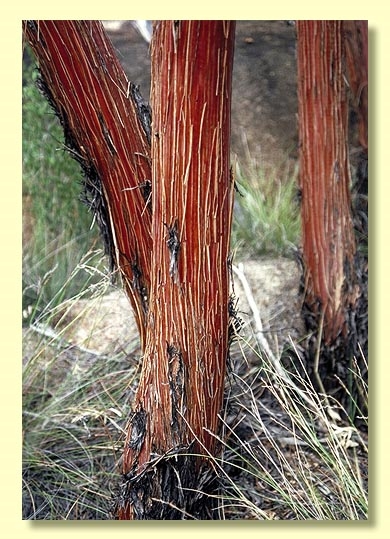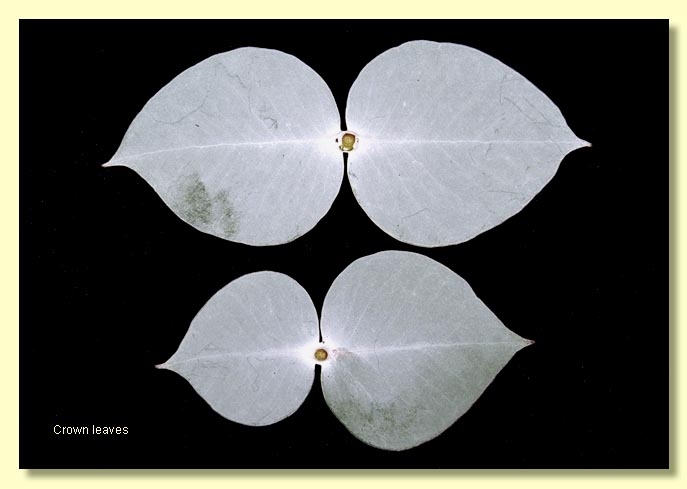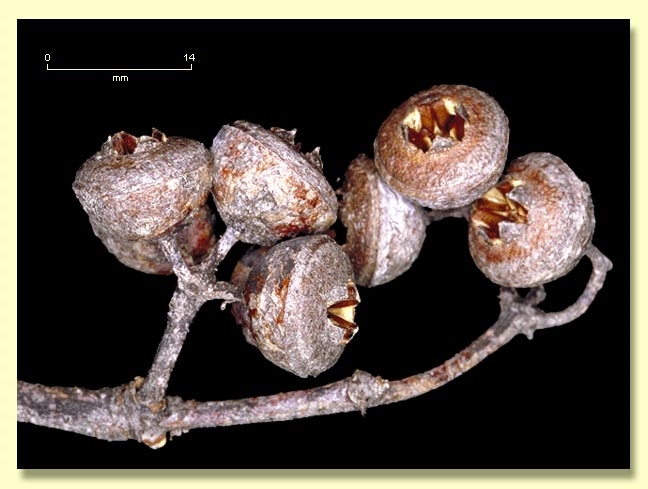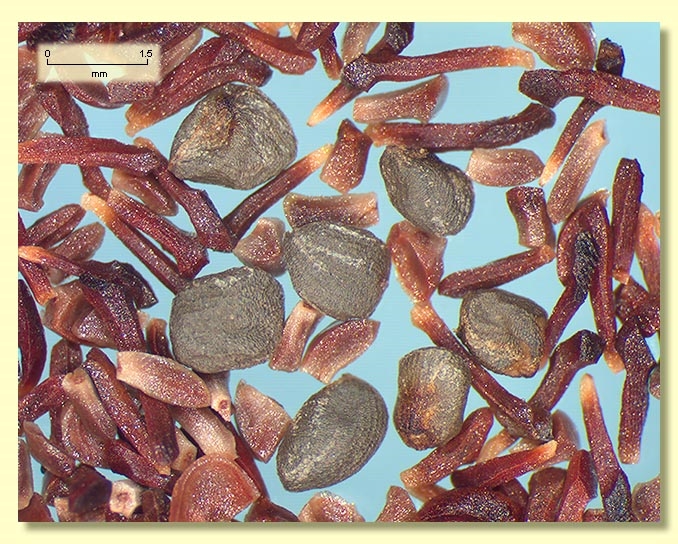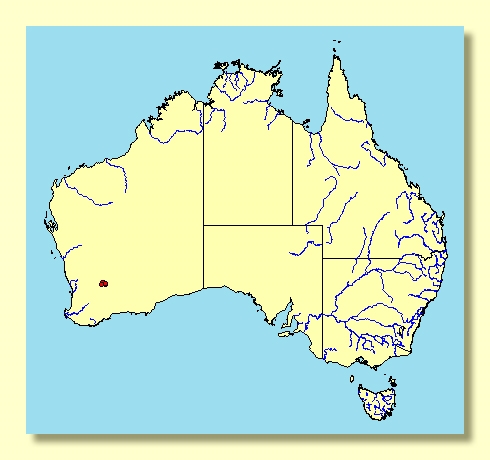Euclid - Online edition
Eucalyptus crucis subsp. crucis
Classification
Eucalyptus | Symphyomyrtus | Bisectae | Destitutae | Curviptera | Orbifoliae
Nomenclature
Eucalyptus crucis Maiden, Crit. Revis. Eucalyptus 6: 514 (1923) subsp. crucis.
T: Southern Cross, W.A., Apr. 1922, H.Steedman s.n.; holo: NSW.
T: Southern Cross, W.A., Apr. 1922, H.Steedman s.n.; holo: NSW.
Description
Mallee to 15 m tall. Forming a lignotuber.
Bark minnirichi on trunk and larger branches, green-fawn over rich red-brown.
Branchlets glaucous; lacking oil glands in the pith.
Juvenile growth (coppice or field seedlings to 50 cm): stems rounded in cross-section, glaucous; juvenile leaves sessile, opposite, usually orbicular or wider than long, 1.7–5.5 cm long, 2.3–6.5 cm wide, amplexicaul, usually glaucous.
Crown of mostly sessile, opposite, orbicular to cordate juvenile leaves, rarely with intermediate leaves that are sub-opposite to alternate with petioles to 0.2 cm long with blade tending to ovate-lanceolate; crown leaves generally with blades 1.7–6.5 cm long, 1.3–6.5 cm wide, base amplexicaul to rounded, margin entire, apex rounded and mucronate or pointed, concolorous, white-grey with copious surface wax or grey-green with only a faint bloom, side-veins greater than 45° to midrib, reticulation dense, intramarginal vein absent or close to margin, oil glands intersectional, large, scattered.
Inflorescence axillary unbranched, peduncles slender, 0.7–1.6 cm long, buds 7 per umbel, pedicels 0.4–0.6 cm long. Mature buds ovoid to slightly elongate-globular (0.9–1.5 cm long, 0.6–0.8 cm wide), glaucous to pinkish, scar present, operculum obtusely conical to rounded (0.5–0.8 cm long), stamens oblique (a few inner stamens may be terminally deflexed), anthers versatile, sub-basifixed, dehiscing by longitudinal slits, style long and straight, stigma rounded to blunt, locules 4 or 5, the placentae each with 4 vertical rows of ovules with a conspicuous longitudinal median gap. Flowers whitish to pale yellow.
Fruit usually pedicellate, rarely sessile (pedicels (0)0.1–0.6 cm long), broadly obconical to hemispherical, 0.5–0.8 cm long, 1–1.5 cm wide, glaucous or non-glaucous, disc slightly raised, valves 4 or 5, exserted.
Seeds dark grey-brown, 1–2 mm long, ovoid to slightly flattened-ovoid, scarcely ridged, dorsal surface scarcely reticulate, hilum ventral.
Cultivated seedlings (measured at ca node 10): cotyledons Y-shaped (bisected); stems rounded in cross-section, glaucous, smooth or slightly warty; leaves sessile, opposite, orbicular or wider than long, 2.5–5.5 cm long, 4–7.5 cm wide, base amplexicaul, apex rounded and mucronate to pointed, glaucous or sometimes grey-green.
Bark minnirichi on trunk and larger branches, green-fawn over rich red-brown.
Branchlets glaucous; lacking oil glands in the pith.
Juvenile growth (coppice or field seedlings to 50 cm): stems rounded in cross-section, glaucous; juvenile leaves sessile, opposite, usually orbicular or wider than long, 1.7–5.5 cm long, 2.3–6.5 cm wide, amplexicaul, usually glaucous.
Crown of mostly sessile, opposite, orbicular to cordate juvenile leaves, rarely with intermediate leaves that are sub-opposite to alternate with petioles to 0.2 cm long with blade tending to ovate-lanceolate; crown leaves generally with blades 1.7–6.5 cm long, 1.3–6.5 cm wide, base amplexicaul to rounded, margin entire, apex rounded and mucronate or pointed, concolorous, white-grey with copious surface wax or grey-green with only a faint bloom, side-veins greater than 45° to midrib, reticulation dense, intramarginal vein absent or close to margin, oil glands intersectional, large, scattered.
Inflorescence axillary unbranched, peduncles slender, 0.7–1.6 cm long, buds 7 per umbel, pedicels 0.4–0.6 cm long. Mature buds ovoid to slightly elongate-globular (0.9–1.5 cm long, 0.6–0.8 cm wide), glaucous to pinkish, scar present, operculum obtusely conical to rounded (0.5–0.8 cm long), stamens oblique (a few inner stamens may be terminally deflexed), anthers versatile, sub-basifixed, dehiscing by longitudinal slits, style long and straight, stigma rounded to blunt, locules 4 or 5, the placentae each with 4 vertical rows of ovules with a conspicuous longitudinal median gap. Flowers whitish to pale yellow.
Fruit usually pedicellate, rarely sessile (pedicels (0)0.1–0.6 cm long), broadly obconical to hemispherical, 0.5–0.8 cm long, 1–1.5 cm wide, glaucous or non-glaucous, disc slightly raised, valves 4 or 5, exserted.
Seeds dark grey-brown, 1–2 mm long, ovoid to slightly flattened-ovoid, scarcely ridged, dorsal surface scarcely reticulate, hilum ventral.
Cultivated seedlings (measured at ca node 10): cotyledons Y-shaped (bisected); stems rounded in cross-section, glaucous, smooth or slightly warty; leaves sessile, opposite, orbicular or wider than long, 2.5–5.5 cm long, 4–7.5 cm wide, base amplexicaul, apex rounded and mucronate to pointed, glaucous or sometimes grey-green.
Flowering Time
Flowering has been recorded in November.
Notes
Eucalyptus crucis is a species with sprawling mallee or small tree habit, endemic to Western Australia, of restricted and sporadic distribution east and north-east of Perth in the east-central wheatbelt and further north, always associated with large granite rocks (inselbergs). The bark is minnirichi throughout or in part, and crown leaves grey to glaucous, and both bark and shape of leaves vary with the subspecies. Buds are also glaucous to pinkish and ± elongate-globular with the stamens arranged obliquely inside the bud (viewed in longitudinal section).
It belongs in Eucalyptus subgenus Symphyomyrtus section Bisectae subsection Destitutae because buds have two opercula, cotyledons are Y-shaped and branchlets lack oil glands in the pith. Within this subsection E. crucis is in series Curviptera, one of about 30 closely related species and subspecies which are further characterised by having large buds in umbels of one, three or seven, staminal filaments erect or oblique (rarely inflexed) in bud, and large fruit usually with an ascending disc and exserted valves.
Within the series Curviptera this species is most closely related to E. ewartiana, E. orbifolia, E. websteriana and E. educta, and together they form a subgroup, subseries Orbifoliae. All have minnirichi bark, buds in umbels of three or seven (rarely 11). All have stamens arranged obliquely in bud except E. educta, which has erect stamens. All have seed that are angularly ovoid though scarcely ridged. E. crucis differs from these close relatives by the combination of the following features—obtusely ovoid to globular buds with pale creamy yellow flowers, seedling and juvenile leaves sessile, opposite and orbicular for many nodes and branchlets glaucous.
There are three subspecies:
E. crucis subsp. crucis
The mature crown consists of round, glaucous juvenile leaves and the subspecies is restricted in distribution to the eastern part of the wheatbelt, between Merredin, Southern Cross and Westonia.
E. crucis subsp. lanceolata
The mature crown consists of alternate, petiolate, lanceolate, grey-green adult leaves and the basal bark may become, on larger plants, a thick accumulation of numerous 'minnirichi strips'. It is sporadically distributed from Pikaring Hill near Corrigin north to Cullimbin and Mt Churchman, and east to Chiddarcooping Rock area.
E. crucis subsp. praecipua
The mature crown consists of alternate, petiolate, lanceolate adult leaves but with larger leaves, buds and fruit than subsp. lanceolata. The basal bark is rough, thick and with the outermost layer of coarse criss-crossed fibrous loose strips on the trunk and larger branches, becoming minnirichi only on smaller branches. Currently known only from south-west of Paynes Find at Wardagga Hill.
Eucalyptus crucis subsp. crucis is listed as "Vulnerable"and E. crucis subsp. praecipua is listed as "Endangered" under the Australian Government Environment Protection and Biodiversity Conservation Act 1999 (EPBC Act). Further information may be found at this web address:
http://www.environment.gov.au/cgi-bin/sprat/public/sprat.pl
It belongs in Eucalyptus subgenus Symphyomyrtus section Bisectae subsection Destitutae because buds have two opercula, cotyledons are Y-shaped and branchlets lack oil glands in the pith. Within this subsection E. crucis is in series Curviptera, one of about 30 closely related species and subspecies which are further characterised by having large buds in umbels of one, three or seven, staminal filaments erect or oblique (rarely inflexed) in bud, and large fruit usually with an ascending disc and exserted valves.
Within the series Curviptera this species is most closely related to E. ewartiana, E. orbifolia, E. websteriana and E. educta, and together they form a subgroup, subseries Orbifoliae. All have minnirichi bark, buds in umbels of three or seven (rarely 11). All have stamens arranged obliquely in bud except E. educta, which has erect stamens. All have seed that are angularly ovoid though scarcely ridged. E. crucis differs from these close relatives by the combination of the following features—obtusely ovoid to globular buds with pale creamy yellow flowers, seedling and juvenile leaves sessile, opposite and orbicular for many nodes and branchlets glaucous.
There are three subspecies:
E. crucis subsp. crucis
The mature crown consists of round, glaucous juvenile leaves and the subspecies is restricted in distribution to the eastern part of the wheatbelt, between Merredin, Southern Cross and Westonia.
E. crucis subsp. lanceolata
The mature crown consists of alternate, petiolate, lanceolate, grey-green adult leaves and the basal bark may become, on larger plants, a thick accumulation of numerous 'minnirichi strips'. It is sporadically distributed from Pikaring Hill near Corrigin north to Cullimbin and Mt Churchman, and east to Chiddarcooping Rock area.
E. crucis subsp. praecipua
The mature crown consists of alternate, petiolate, lanceolate adult leaves but with larger leaves, buds and fruit than subsp. lanceolata. The basal bark is rough, thick and with the outermost layer of coarse criss-crossed fibrous loose strips on the trunk and larger branches, becoming minnirichi only on smaller branches. Currently known only from south-west of Paynes Find at Wardagga Hill.
Eucalyptus crucis subsp. crucis is listed as "Vulnerable"and E. crucis subsp. praecipua is listed as "Endangered" under the Australian Government Environment Protection and Biodiversity Conservation Act 1999 (EPBC Act). Further information may be found at this web address:
http://www.environment.gov.au/cgi-bin/sprat/public/sprat.pl
Origin of Name
Eucalyptus crucis: Latin crucis, of the cross, referring to the town of Southern Cross near where the species occurs.
Copyright © CANBR 2020, all rights reserved.

Web edition hosted at https://apps.lucidcentral.org/euclid

